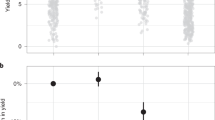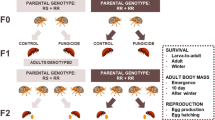Abstract
An international initiative is developing a scientifically rigorous approach to evaluate the potential risks to nontarget arthropods (NTAs) posed by insect-resistant, genetically modified (IRGM) crops. It adapts the tiered approach to risk assessment that is used internationally within regulatory toxicology and environmental sciences. The approach focuses on the formulation and testing of clearly stated risk hypotheses, making maximum use of available data and using formal decision guidelines to progress between testing stages (or tiers). It is intended to provide guidance to regulatory agencies that are currently developing their own NTA risk assessment guidelines for IRGM crops and to help harmonize regulatory requirements between different countries and different regions of the world.
This is a preview of subscription content, access via your institution
Access options
Subscribe to this journal
Receive 12 print issues and online access
$209.00 per year
only $17.42 per issue
Buy this article
- Purchase on Springer Link
- Instant access to full article PDF
Prices may be subject to local taxes which are calculated during checkout


Similar content being viewed by others
References
James, C. Global status of commercialized biotech/GM crops: 2006. ISAAA Briefs No. 35 (International Service for the Acquisition of Agric.-Biotech Applications, Ithaca, NY, USA, 2005).
Nap, J.P., Metz, P.L.J., Escaler, M. & Conner, A.J. The release of genetically modified crops into the environment - Part I. Overview of current status and regulations. Plant J. 33, 1–18 (2003).
Conner, A.J., Glare, T.R. & Nap, J.P. The release of genetically modified crops into the environment - Part II. Overview of ecological risk assessment. Plant J. 33, 19–46 (2003).
Rose, R.I. (ed.) White paper on tier-based testing for the effects of proteinaceous insecticidal plant-incorporated protectants on non-target invertebrates for regulatory risk assessment (USDA-APHIS and US Environmental Protection Agency, Washington, DC, USA, 2007). <http://www.epa.gov/pesticides/biopesticides/pips/non-target-arthropods.pdf>
Canadian Food Inspection Agency. Assessment criteria for determining environmental safety of plants with novel traits. Directive 94–08 (Canadian Food Inspection Agency, Government of Canada, Ottawa, Ontario, 2004).
European Community (EC). Directive 2001/18/EC of the European Parliament and of the Council of 12 March 2001 on the deliberate release into the environment of genetically modified organisms and repealing Council Directive 90/220/EEC. Off. J. Eur. Commun. L 106, 1–39 (2001). <http://ec.europa.eu/environment/biotechnology/pdf/dir2001_18.pdf>
European Commission (EC). Commission Decision (2002/623/EC) of 24 July 2002 establishing guidance notes supplementing Annex II to Directive 2001/18/EC of the European Parliament and of the Council of the deliberate release in to the environment of genetically modified organisms and repealing Council Directive 90/220/EEC. Off. J. Eur. Commun. L 200, 22–33 (2002). <http://ec.europa.eu/environment/biotechnology/pdf/dec2002_623.pdf>
European Food Safety Authority (EFSA). Guidance document of the Scientific Panel on Genetically Modified Organisms for the risk assessment of genetically modified plants and derived food and feed. EFSA J. 99, 1–100 (2006). <http://www.efsa.europa.eu/EFSA/Scientific_Document/ gmo_guidance_gm_plants_en,0.pdf>
Secretariat of the Convention on Biological Diversity. Cartagena Protocol on Biosafety to the Convention on Biological Diversity: Text and Annexes (Secretariat of the Convention on Biological Diversity, Montreal, Canada, 2000).
Romeis, J. Non-target risk assessment of GM crops and regulation. IOBC WPRS Bull. 29(5), 197–200 (2006).
Wolt, J.D. & Peterson, K.D. Agricultural biotechnology and societal decision-making: the role of risk analysis. AgBioForum 3, 39–46 (2000). <http://www.agbioforum.org/v3n1/v3n1a06-wolt.htm>
Johnson, K.L., Rabould, A.F., Hudson, M.D. & Poppy, G.M. How does scientific risk assessment of GM crops fit within the wider risk analysis? Trends Plant Sci. 12, 1–5 (2007).
US Environmental Protection Agency (USEPA). Guidelines for ecological risk assessment. EPA 630/R-95–002F (Environmental Protection Agency, Washington, DC, USA, 1998).
Raybould, A. Problem formulation and hypothesis testing for environmental risk assessments of genetically modified crops. Environ. Biosafety Res. 5, 119–125 (2006).
National Research Council (NRC). Field testing genetically modified organisms: framework for decisions (NRC Committee on Scientific Evaluation of the Introduction of Genetically Modified Microorganisms and Plants into the Environment, National Academy Press, Washington, DC, 1989).
Tiedje, J.M. et al. The planned introduction of genetically modified organisms: ecological considerations and recommendations. Ecology 70, 298–315 (1989).
Hokanson, K. et al. The concept of familiarity and pest resistant plants. in Proc., Ecological Effects of Pest Resistance Genes in Managed Ecosystems, January 31–February 3, 1999, Bethesda, Maryland (eds. Trayner, P.L. & Westwood, J.H.), 15–19 (Information Systems for Biotechnology, Blacksburg, Virginia, USA, 1999).
Organisation for Economic Cooperation and Development (OECD). Safety considerations for biotechnology: scale-up of crop plants (Organisation for Economic Cooperation and Development, Paris, 1993). <http://www.oecd.org/dataoecd/26/26/1958527.pdf? channelld=34537&homeChannelld=33703&file Title=Safety+Considerations+for+Biotechnology+Scale-up+of+Crop+Plants>
Kuiper, H.A., Kleter, G.A., Noteborn, H.P.J.M. & Kok, E.J. Assessment of the food safety issues related to genetically modified foods. Plant J. 27, 503–528 (2001).
Bradford, K.J., Van Deynze, A., Gutterson, N., Parrott, W. & Strauss, S.H. Regulating transgenic crops sensibly: lessons from plant breeding, biotechnology and genomics. Nat. Biotechnol. 23, 439–444 (2005).
Glare, T.R. & O'Callaghan, M. Bacillus thuringiensis: Biology, Ecology and Safety (John Wiley & Sons Ltd, Chichester, UK, 2000).
Romeis, J., Meissle, M. & Bigler, F. Transgenic crops expressing Bacillus thuringiensis toxins and biological control. Nat. Biotechnol. 24, 63–71 (2006).
Hill, R.A. & Sendashonga, C. General principles for risk assessment of living modified organisms: lessons from chemical risk assessment. Environ. Biosafety Res. 2, 81–88 (2003).
Touart, L.W. & Maciorowski, A.F. Information needs for pesticide registration in the United States. Ecol. Appl. 7, 1086–1093 (1997).
Peters, R.H. A Critique for Ecology (Cambridge University Press, Cambridge, UK, 1991).
Marvier, M., McCreedy, C., Regetz, J. & Kareiva, P. A meta-analysis of effects of Bt cotton and maize on nontarget invertebrates. Science 316, 1475–1477 (2007).
Dutton, A., Romeis, J. & Bigler, F. Assessing the risks of insect resistant transgenic plants on entomophagous arthropods: Bt-maize expressing Cry1Ab as a case study. BioControl 48, 611–636 (2003).
Barrett, K.L., Grandy, N., Harrison, E.G., Hassan, S. & Oomen, P. (eds.) Guidance document on regulatory testing procedures for pesticides with non-target arthropods. From the ESCORT workshop (European Standard Characteristics of Non-Target Arthropod Regulatory Testing) (Society of Environmental Toxicology and Chemistry Europe, Brussels, Belgium, 1994).
American Society for Testing and Materials (ASTM). Standard guide for selection of resident species as test organisms for aquatic and sediment toxicity tests. Document E 1850 (American Society for Testing and Materials ASTM International, West Conshohocken, Pennsylvania, USA 2004).
Scholte, E.J. & Dicke, M. Effects of insect-resistant transgenic crops on non-target arthropods: first step in pre-market risk assessment studies. A literature-based study, proposing an ecologically based first step to select non-target organisms. COGEM report CGM 2005–06 (2005). <http://www.cogem.net/ContentFiles/CGM%202005-06.pdf>
Niemi, G.J. & McDonald, M.E. Application of ecological indicators. Annu. Rev. Ecol. Evol. Syst. 35, 89–111 (2004).
Candolfi, M. et al. Principles for regulatory testing and interpretation of semi-field and field studies with non-target arthropods. J. Pest Sci. 73, 141–147 (2000).
Candolfi, M.P. et al. (eds.). Guidance document on regulatory testing and risk assessment procedures for plant protection products with non-target arthropods. From the ESCORT 2 workshop (European Standard Characteristics of Non-Target Arthropod Regulatory Testing), a joint BART, EPPO/CoE, OECD and IOBC Workshop, organized in conjunction with SETAC Europe and EC (Society of Environmental Toxicology and Chemistry Office, Pensacola, Florida, USA, 2001).
Levin, S.A., Harwell, M.A., Kelly, J.R. & Kimball, K.D. Ecotoxicology problems and approaches. in Ecotoxicology: Problems and Approaches. (ed. Levin, S.A.) 3–8 (Springer, New York, USA, 1989).
Caro, T.M. & O'Doherty, G. On the use of surrogate species in conservation biology. Conserv. Biol. 13, 805–814 (1999).
Duelli, P. & Obrist, M.K. Biodiversity indicators: the choice of values and measures. Agric. Ecosyst. Environ. 98, 87–98 (2003).
Bates, S.L., Zhao, J.-Z., Roush, R.T. & Shelton, A.M. Insect resistance management in GM crops: past, present and future. Nat. Biotechnol. 23, 57–62 (2005).
Candolfi, M.P. et al. (eds.). Guidelines to evaluate side-effects of plant protection products to non-target arthropods (IOBC/WPRS, Gent, Belgium, 2000).
US Environmental Protection Agency (USEPA). Harmonized test guidelines, series 885 microbial pesticide test guidelines OPPTS (Office of Prevention, Pesticides and Toxic Substances Washington, DC, USA, February 1996 <http://www.epa.gov/opptsfrs/publications/ OPPTS_Harmonized/885_Microbial_Pesticide_Test_Guidelines/ index.html>
Raybould, A. et al. Non-target organisms risk assessment of MIR604 maize expressing mCry3A for control of corn rootworms. J. Appl. Entomol. 131, 391–399 (2007).
Jaffe, G. Regulatory slowdown on GM crop decisions. Nat. Biotechnol. 24, 748–749 (2006).
US Environmental Protection Agency (USEPA). Biopesticide registration action document. Bacillus thuringiensis (Bt) plant-incorporated protectants. 15 October 2001. <http://www.epa.gov/oppbppd1/biopesticides/pips/bt_brad.htm>
US Environmental Protection Agency (USEPA). Pesticide fact sheet for Bacillus thuringiensis ssp. kurstaki Cry1(A)b delta-endotoxin and the genetic material necessary for the production (plasmid vector pCIB4431) in corn. EPA publication no. EPA 731-F-95–004 (Environmental Protection Agency, Washington, DC, USA, 1995).
Losey, J.E., Rayor, L.S. & Carter, M.E. Transgenic pollen harms monarch larvae. Nature 399, 214 (1999).
Hellmich, R.L. et al. Monarch larvae sensitivity to Bacillus thuringiensis-purified proteins and pollen. Proc. Natl. Acad. Sci. USA 98, 11925–11930 (2001).
Dively, G.P. et al. Effects on Monarch butterfly larvae (Lepidoptera: Danaidae) after continuous exposure to Cry1Ab-expresing corn during anthesis. Environ. Entomol. 33, 1116–1125 (2004).
Prasifka, J.R., Hellmich, R.L., Dively, G.P. & Lewis, L.C. Assessing the effects of pest management on nontarget arthropods: The influence of plot size and isolation. Environ. Entomol. 34, 1181–1192 (2005).
Sears, M. et al. Impact of Bt corn pollen on monarch butterfly populations: a risk assessment. Proc. Natl. Acad. Sci. USA 98, 11937–11942 (2001).
Wolt, J.D., Peterson, R.K.D., Bystrak, P. & Meade, T. A screening level approach for nontarget insect risk assessment: transgenic Bt corn pollen and the monarch butterfly (Lepidoptera: Danaidae). Environ. Entomol. 32, 237–246 (2003).
Author information
Authors and Affiliations
Corresponding author
Ethics declarations
Competing interests
J.E.H., R.L. and A.R. are employed by companies that develop and sell GM plants. M.P.C. had been employed by a company that conducts regulatory risk assessment studies and works now for a plant protection company.
Supplementary information
Supplementary Text and Figures
Supplementary Note 1 (PDF 103 kb)
Rights and permissions
About this article
Cite this article
Romeis, J., Bartsch, D., Bigler, F. et al. Assessment of risk of insect-resistant transgenic crops to nontarget arthropods. Nat Biotechnol 26, 203–208 (2008). https://doi.org/10.1038/nbt1381
Published:
Issue Date:
DOI: https://doi.org/10.1038/nbt1381
This article is cited by
-
Bioinformatic and literature assessment of toxicity and allergenicity of a CRISPR-Cas9 engineered gene drive to control Anopheles gambiae the mosquito vector of human malaria
Malaria Journal (2023)
-
Survivorship and food consumption of immatures and adults of Apis mellifera and Scaptotrigona bipunctata exposed to genetically modified eucalyptus pollen
Transgenic Research (2023)
-
Transgenic Bt cotton expressing Cry1Ac/1Ab does not have detrimental effects on the predator Arma chinensis through its prey Helicoverpa armigera
Journal of Pest Science (2023)
-
Does the growing of Bt maize change abundance or ecological function of non-target animals compared to the growing of non-GM maize? A systematic review
Environmental Evidence (2022)
-
Southern pine beetle-specific RNA interference exhibits no effect on model nontarget insects
Journal of Pest Science (2022)



